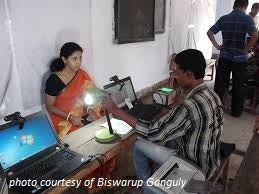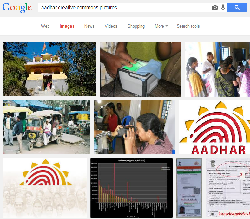 At a recent lunchtime presentation, World Bank staff had the opportunity to hear about the progress of the Government of India’s Aadhaar program. Aadhaar, which means ‘foundation’ in English, is a 12 digit individual identification number issued to each resident in India by the Unique Identification Authority of India (UIDAI). The program aims to provide a unique ID to 1.2 billion residents and is, as such, the largest ID project of its kind currently in the world. Beyond registration of citizens, it will allow identifying and finding citizens who qualify for social benefits and social protection services but have been excluded until now for a variety of reasons including lack of documentation, cast system and gender. Aadhaar is seen by many as one of key means to enable social and financial inclusion in India.
At a recent lunchtime presentation, World Bank staff had the opportunity to hear about the progress of the Government of India’s Aadhaar program. Aadhaar, which means ‘foundation’ in English, is a 12 digit individual identification number issued to each resident in India by the Unique Identification Authority of India (UIDAI). The program aims to provide a unique ID to 1.2 billion residents and is, as such, the largest ID project of its kind currently in the world. Beyond registration of citizens, it will allow identifying and finding citizens who qualify for social benefits and social protection services but have been excluded until now for a variety of reasons including lack of documentation, cast system and gender. Aadhaar is seen by many as one of key means to enable social and financial inclusion in India.
Already at an event a year ago, World Bank President Jim Yong Kim called the program a “ poverty killer” and related the program’s benefits to the World Bank’s pursuit of a “science of delivery” to help improve the results of our projects.
At this year’s presentation, we heard from Guru Malladi (Ernst and Young Project Director, India), Tilman Ehrbeck (CGAP CEO), and Alan Gelb (Senior Fellow, Center for Global development).
Guru Malladi shared impressive rollout numbers: as of March 2014, 600 million citizens were registered and had received an identification number. This means 600 million people have already provided basic demographic information (Name, Date of Birth, Gender, Address, Parent/Guardian details (for children), Contact details ph
 one and email) and now have a biometric record (digital photo, 10 fingerprints, and iris scan) to ensure that every identity number allocated has only one match. Some of the creative commons pictures in
this Google search capture the process.
one and email) and now have a biometric record (digital photo, 10 fingerprints, and iris scan) to ensure that every identity number allocated has only one match. Some of the creative commons pictures in
this Google search capture the process.
The program has been adopted across all public services and welfare programs covering employment, health, social security, food distribution and fuel subsidies. According to Malladi, Aadhaar is helping to reduce the leakage, wastage and diversion of benefits that distort the various welfare schemes of central and state governments in India, making the distribution of benefits more effective, impactful and equitable. Malladi also described how the program is bringing transparency and accountability by simplifying and optimizing processes and approval flows between different agencies.
One of the features which drew the most attention from our World Bank colleagues was the opportunity to increase financial inclusion by linking Aadhaar and programs that seek to increase access to finance and banking. The micro financing programs delivered by CGAP in India are an interesting case in point. GCAP’s CEO Tilman Ehrbeck referred to Aadhaar as an infrastructure innovation, that is necessary, but not sufficient, to reduce poverty.
This being a numbers crowd, we also had a lively debate about the expected cost savings that could come from efficiency gains and the reduction of welfare program leakages. We estimated that the savings could be around $100 billion per year (20% of a $500 billion yearly welfare budget)-- savings which could be allocated to poverty reduction programs, public education, nutrition, etc.
Finally, Alan Gelb described a contentious experience in Pakistan in 1994 when beneficiaries were fingerprinted for authentication purposes to access conditional cash transfers. Finger printing and biometrics capture in general is often a source of unease for data privacy advocates: Who owns that data? What will be used for? For many of us, the dystopian picture of Orwell’s 1984 universe comes to mind. While such concerns have some validity, I believe we must assume that there are responsible and sound governments, as well as professional administrations behind such identity management efforts.
Governments need a system to capture, retain and update citizens’ records so that citizens receive the benefits and public goods they are due. Identity management is not optional. To me, the advantages of modern information and communication technologies (speed, efficiency, accuracy and use of data analytics for better decision making), coupled with information security and data privacy features, are obvious. (Good luck keeping track of life cycle events and monthly benefits of billions of people, as well as their location and family linkages, through a paper trail.) Furthermore, citizens in developing countries, increasingly aware of the quality of life elsewhere (see JYK’s blog) are now demanding better services -- and accountability -- from their governments.
Today we are seeing an increase in demand for electronic IDs (eID), or Mobile ID (mID) projects from our World Bank client countries across a variety of ministries and projects. The Bank’s ICT Unit will soon publish an eID Toolkit to understand what is an eID (or mID), and how can it be used to end extreme poverty and boost shared prosperity. So stay tuned!


Join the Conversation